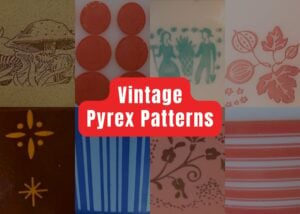Pyrex dishes are among the most common items in American homes, used for many cooking activities. But not everyone knows that some of these pieces are worth treasuring today, simply because they have a rare pattern.
But the key is to know exactly which patterns are worth the money! In this guide, I’ll introduce you to some of the most collectible and popular vintage Pyrex patterns, their worth, and some tips to spot valuable Pyrex in your home.
A Brief History of Pyrex Cookware
You may know Pyrex today as those white casseroles or bowls with colorful patterns. But did you know that Pyrex was originally released as clear, low-thermal-expansion glass?
Initially, it was the Nonex glass with less breakage that Pyrex’s parent company, Corning Inc., had developed in 1908 for the railway industry. But soon, the company decided to make the glass lead-free and use it to make cookware for the public.
But it wasn’t until the mid-1940s that Pyrex’s parent company, Corning Inc., moved to opal (white) glass. This new glass also became the base for many vibrant floral and abstract patterns, making vintage Pyrex the latest hype!
Pyrex Production Over the Years (1915 to 1998)
Corning introduced its Pyrex clear cookware range in 1915, followed by the Pyrex colorware in 1945. The brand sold 4 million pieces in just four years after its launch. Over the next eight years, the numbers soared to 26 million.
By 1998, Corning decided to discontinue its customer product division and shift its focus to high-technology sectors, such as fiber optics.
Are Pyrex Vintage Dishes Worth Money?
Vintage Pyrex dishes are pretty popular today for their amazing quality and aesthetic looks, which also make them valuable. But the actual value depends on several factors, such as:
1. Patterns
The pattern of a Pyrex dish is the first and most important value factor. The company released around 176 patterns during its run from 1945 to 1998.
Some of these Pyrex patterns became highly popular and expensive due to their rarity of color or style, limited production, and cultural significance.
So, make sure to check the pattern type and do some research to find out its name, production year, discontinuation year, and whether it’s rare!
2. Condition
Assessing the condition and use of a vintage Pyrex dish gives you a brief idea of whether the product is valuable. For example, dishes with chips, discoloration, and scratches are valued less than those that are still in mint condition or come in the original box.
3. Shape
The shape of the Vintage Pyrex dish also impacts its value. But, it’s not a standalone factor; you should also consider the completeness of the set, practicality, and more.
For instance, when Pyrex introduced the Cinderella bowls with handles and pour lips, home cooks instantly fell in love with them: no messy spills or greasy countertops.
But today collectors tend to pass by these models because they take up more space in the cupboard.
4. The Backstamp
The backstamp is one of the easiest ways to identify true vintage Pyrex. So, always flip the dish over and check the bottom to verify the following details:
- “PYREX” written Serif font in all caps within a simple circle means a genuine vintage piece.
- A registered trademark symbol “®” means post-1950 pieces.
- The model number and capacity are typically listed in quarts or pints in earlier models.
5. The Type of Material
When Pyrex debuted in 1915, its dishes were made of borosilicate glass. This material is characterized by its high resistance to extreme temperatures without cracking. Later, Pyrex launched the Colorware series, which used tempered opal glass material.
Today, most modern pieces are made using tempered soda-lime material, an inexpensive alternative to borosilicate. Keep this in mind when searching for a vintage Pyrex, as it affects the overall value.
Collectible Vintage Pyrex Patterns to Find in 2025
Let’s take a look at 20 of the most popular vintage Pyrex patterns collectors are crazy for today!
1. The Duchess Pattern (1959)
One of the rarest Pyrex patterns, the Duchess pattern was released in 1959 as a promotional item for Stanley’s hostess parties. The pattern features a beautiful, 22K gold floral scroll on a pale pink milk-glass background, a genuine compliment to the name!
- Average Price – $1,000 to $3,500+ (for lidded casserole dishes)
- Manufacturing Year – 1959
- Production Status – Discontinued
- Piece Types – Casserole dishes, Juice carafe, Percolator, Sugar/creamer sets
- Color – Gold against pink
- Rarity Level – Rare
- Production Note – Promotional Launch
- Special Feature – 22k Gold Decoration
Notable Examples:

2-quart round casserole dishes, like this example, are the most popular Pyrex Duchess items. These came with a clear glass lid marked with “Pyrex” and a metal warming stand. A complete set with all the additional items can be worth $1,000 to $3,500, even more with the original pink box.
2. Blackstar (Unofficial Pattern Name)
This is another highly scarce Pyrex pattern, and it’s likely to be rare to come across this pattern. You can spot it by a matte-black star subtly placed against the milky-white glass.
This pattern was likely a test pattern with only a few pieces made. But the Pyrex collectors fondly call it Blackstar, highlighting the unique design.
- Average Price – $1,000 to $3,000
- Manufacturing Period – Late 1950s
- Production status – Discontinued
- Piece Types – Mini Casserole
- Color & Design – Matte Black Star on Milky White Glass
- Rarity Level – Extremely Rare
- Production Note – Test Piece/Limited Edition
Valuable Examples:
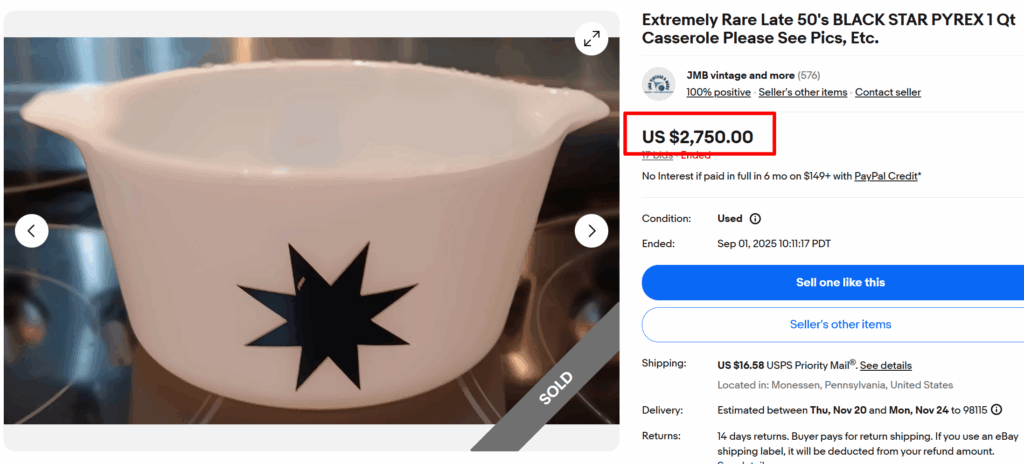
This rare Blackstar Pyrex 1-qt casserole dish is #473, as marked on the bottom. The number #473 denotes the model number and size of the casserole. While this example doesn’t have a lid, original Black Star casseroles likely came with a clear lid. The rarity of this pattern gives it a high value of a few thousand dollars.
3. Ducks in the Marsh/Duck Hunt (1960s)
The Duck Hunt pattern is not just rare, but also poorly documented. Unlike other Pyrex patterns that use screen printing, this one uses decals. It features flying ducks and marsh plants in light brown and light green shades.
Collectors often confuse this pattern with British JAJ Pyrex’s ‘Wild Fowl’ pattern. So, how will you differentiate them? Flip the Vintage Pyrex with the Duck Hunt pattern and check the backstamp. The original Pyrex Duck Hunt piece would show the ‘made in the USA’ mark and have an all-caps PYREX stamp.
- Average Price – $1,000 to $1,500
- Manufacturing Period – 1960s
- Production Status – Not in production
- Piece Types – Casserole
- Color – Earthy tones against white opal glass
- Rarity Level – Extremely rare
- Production Note: Minimal production/ test piece
Rare Examples:
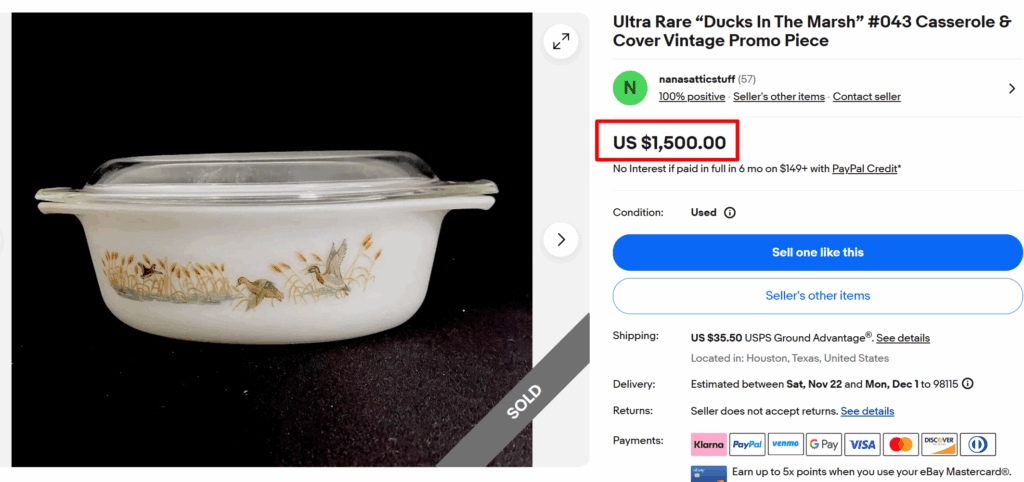
A large “Ducks in the Marsh” casserole, like this 1.5 qt piece, is extremely rare, as they were likely produced in small quantities. Pyrex released these casseroles with a clear glass lid. This piece is a must-add to your Pyrex collection.
4. Gooseberry (1957 – 1966)
Gooseberry is Pyrex’s most notable pattern. The company introduced it in 1957, as one of the first four patterns released in the Opal series, and the first to debut on the Cinderella bowls.
The pattern features pink gooseberry leaves, flowers, and berries against a white background. You can also find other color variations, such as white-on-pink, black-on-white, and black-on-yellow, but the black pattern was discontinued in 1962.
A limited number of gold gooseberry patterns on a beige background is also available. This pattern might be a promotional or test pattern; hence, it is rare to find. The brand stopped the entire line of gooseberry patterns in 1966.
- Average Price – $500 to $1,750 (complete sets in pink or yellow)
- Manufacturing Period – 1957 to 1966
- Production Status – Discontinued
- Piece Types – Cinderella bowls, Cinderella casserole, refrigerator set
- Color – Pink on White, Black on White, Black on Yellow, Gold on Beige
- Rarity Level – Common
- Production Note: Gold-Beige bowls Were Promotional Items
Notable Examples to Check:
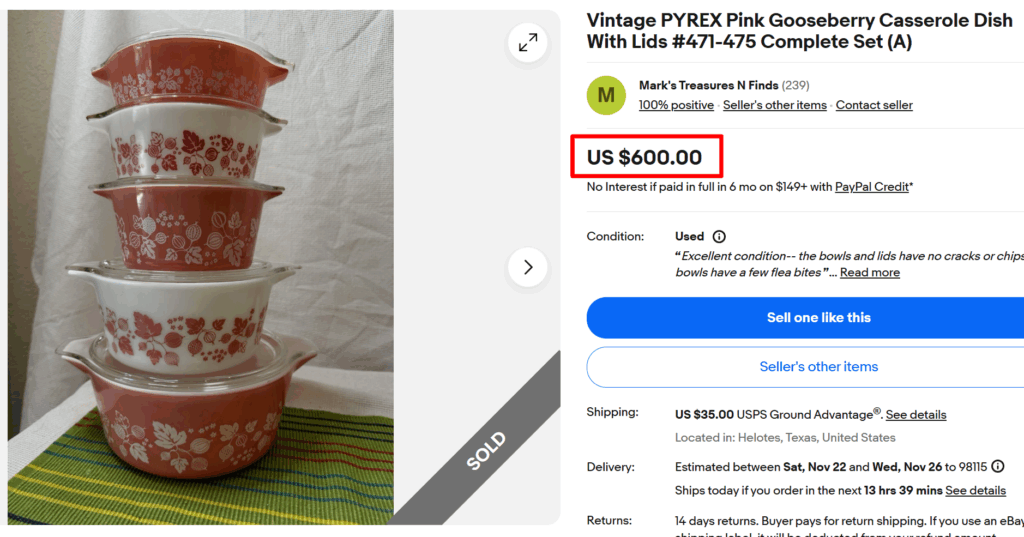
This is a full set of 5 Pink Gooseberry casserole dishes #471 to #475, all with clear lids. Such sets can easily be valued at $300 to $600.

Here is a set of yellow Gooseberry nesting bowls. This is a rare color variant for this pattern, making it worth the price tag of $500. Also, the set came with the original Pyrex box, which has added to the value.
5. Amish Butterprint (1957 to 1968)
Amish butterprint is a very popular and common pattern launched by Pyrex in 1957. As the name suggests, it depicts a rustic farm scene, featuring an Amish couple holding farming tools, roosters, and wheat and corn stalks.
What makes Amish Butterprint notable is that it’s one of the first patterns to be used on the Cinderella nesting bowls. Also, it was released in a few colors, with turquoise-on-white and white-on-turquoise being the most popular.
Other color variants were pumpkin orange butterprint on a white background and vice versa. The butterprint pattern had a decade-long run, and this success led to the production of many different pieces.
- Average Price – $400 to $1,800 (for full sets)
- Manufacturing Period – 1957 – 1968
- Production Status – Discontinued
- Piece Types: Cinderella mixing bowls, casserole, bakeware, serveware, store sets, refrigerator & freezer sets
- Colors – Turquoise, pink, pumpkin orange
- Rarity Level – Common
- Production Note: Pumpkin orange butterprint is a promotional pattern
Rare Examples to Check:
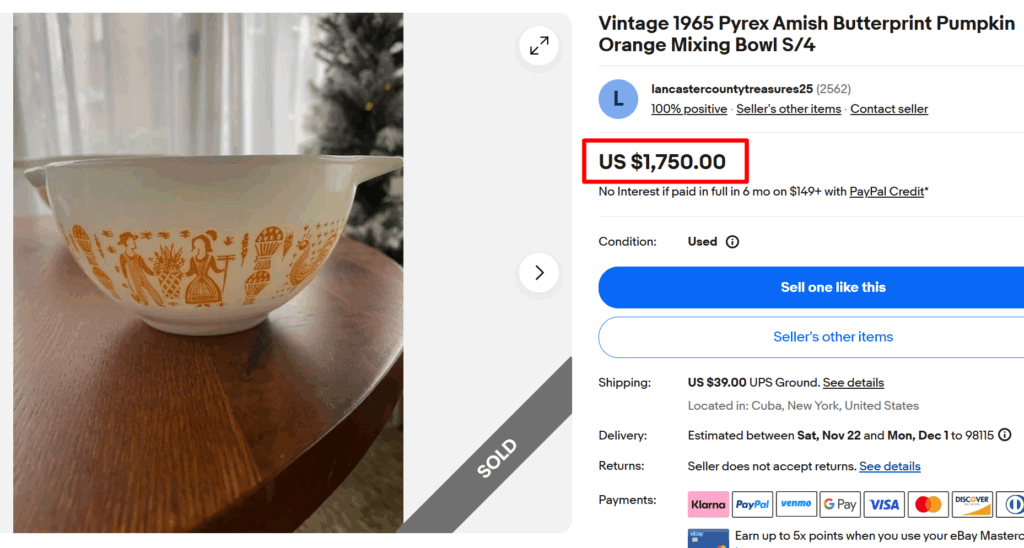
This is a set of pumpkin orange butterprint nesting bowls, numbered #441, #442, #443, and #444 (for different sizes). Since this pattern was released as a promotional piece, complete sets are super rare and valuable, selling for hundreds to thousands of dollars or more.
6. Pink Stems (1962)
Pink Stems is another non-standard, promotional release with minimal production. The pattern features vertical white stems with leaves on a pink milk glass background. This pattern is likely available in the oval casserole (#043), and not in any other shapes, making it collectible.
Collector’s Note: Pink Stem is different from the “Pink Daisy” pattern. While the first one shows white stems & leaves, the latter one features stylized daisies.
- Average Price – $200 to $1,200
- Manufacturing Period – 1962
- Production Status – Not in production
- Piece Types – #043 oval casserole
- Color – white stems and leaves on pink
- Rarity Level – Rare
- Production Note: Limited Promotional Release
Expensive Pieces:
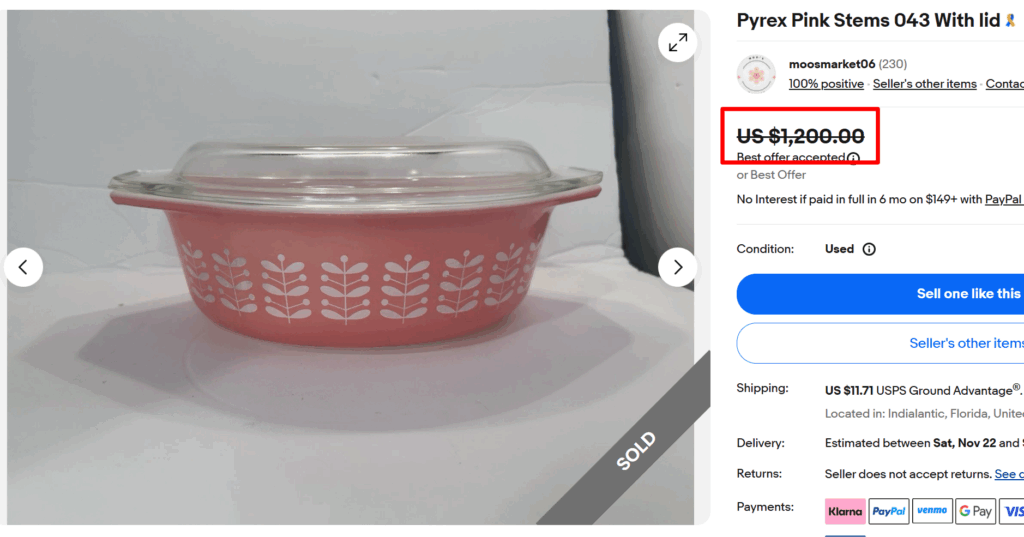
This is an #043 oval casserole, possibly the only shape this pattern is found in. These dishes come with a clear lid with handles, marked with “PYREX” on the edge.
7. Starbust (1960)
While this Star-like pattern is quite popular, “Starburst” is not its official name. Produced as a promotional pattern for one year (1960), this design features a golden star against a light turquoise background. It’s also available in cream and black base, all featuring a golden star.
- Average Price – $200 to $1,500 (for complete set with stand)
- Manufacturing Period – 1960
- Production Status – Discontinued
- Piece Types – #525B casserole
- Color – Golden Star on a Turquoise Base/Cream/Black Base
- Rarity Level – Rare
- Production Note: Promotional Piece
Valuable Pieces to Find:
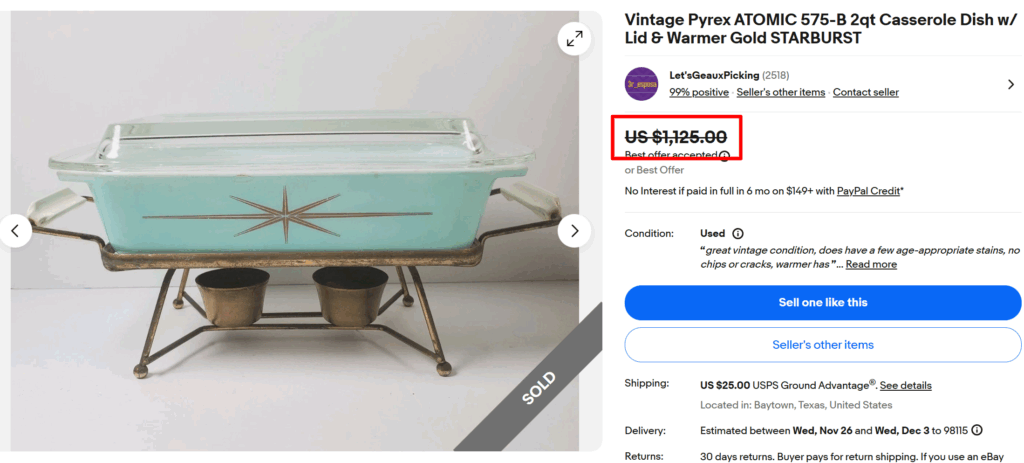
This spacesaver 2-quart #575B casserole features a golden star against a turquoise base. The original piece came with a clear glass lid and a metal cradle with candle warmers. Since it’s a promotional item, these scarce pieces can easily fetch up to $1,000 in excellent condition.
8. Goldenrod Fleur De Lis (Mid 1960s)
Fleur De Lis is a rare, classic pattern that hits nostalgia with its golden fleur-de-lis (a stylized symbol of the lily or iris flower) against a yellow-orange/golden background.
Other color varieties include red, green, and blue. All these variants feature a gold fleur-de-lis pattern, except Blue, which shows a silver pattern on a blue background.
- Average Price – $200 to $1000
- Manufacturing Period – Mid-1960s
- Production Status – Discontinued
- Piece Types – #443 Cinderella bowl
- Color – Goldenrod, Green, Black with Golden Motifs & Blue with Silver Motifs
- Rarity Level – Very Rare
- Production Note: Limited Series
Notable Sold Examples:
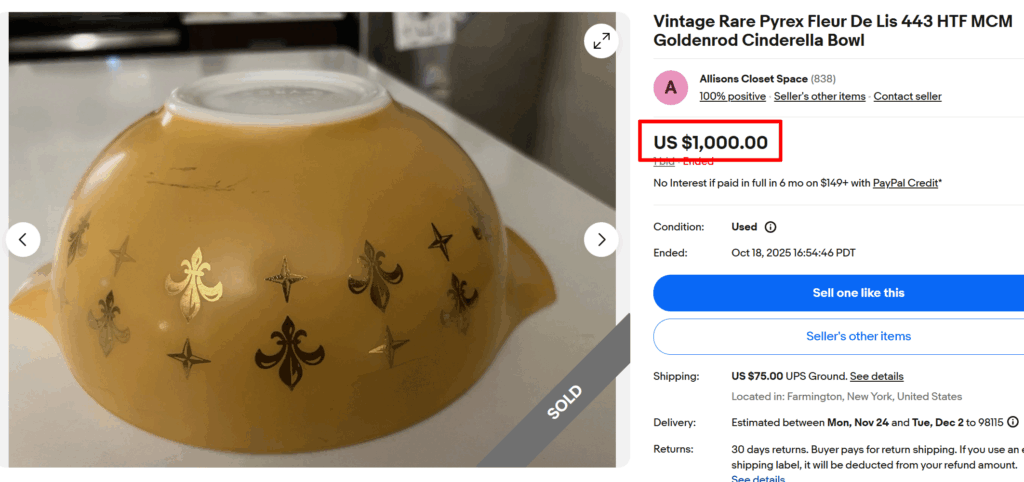
This is a rare #443 Fleur-de-lis Cinderella bowl in a goldenrod tone. This single bowl sold for $1,000, which means that full nesting bowl sets can be worth even more! While the goldenrod color is standard, bowls with the blue-and-silver pattern are ever rarer and more valuable!
9. Old Orchard (1974 to 1978)
Old Orchard is a distinctive pattern designed by Estelle G. Rothstein, featuring a fruit-and-leaves design against a light orange or deep brown background.
It also comes in orange dishes with or without a brown fade around the edge. You may find it in solid colors, with no shading at the top of the dish.
- Average Price – $50 to $250 (Single Pieces), $500+ (for packed sets)
- Manufacturing Period – 1974-1978
- Production Status – Discontinued
- Piece Types – #400 mixing bowls, #440 Cinderella mixing bowls, Casseroles, Serving dish, #664 big Bertha Casserole, Refrigerator Sets
- Color – Golden Orange to Dark Brown
- Rarity Level – Collectible
Real Examples:

This is an old lidded Big Bertha #664 4L casserole with an orange Old Orchard pattern. It likely sold for a moderate price because of its usage and condition.
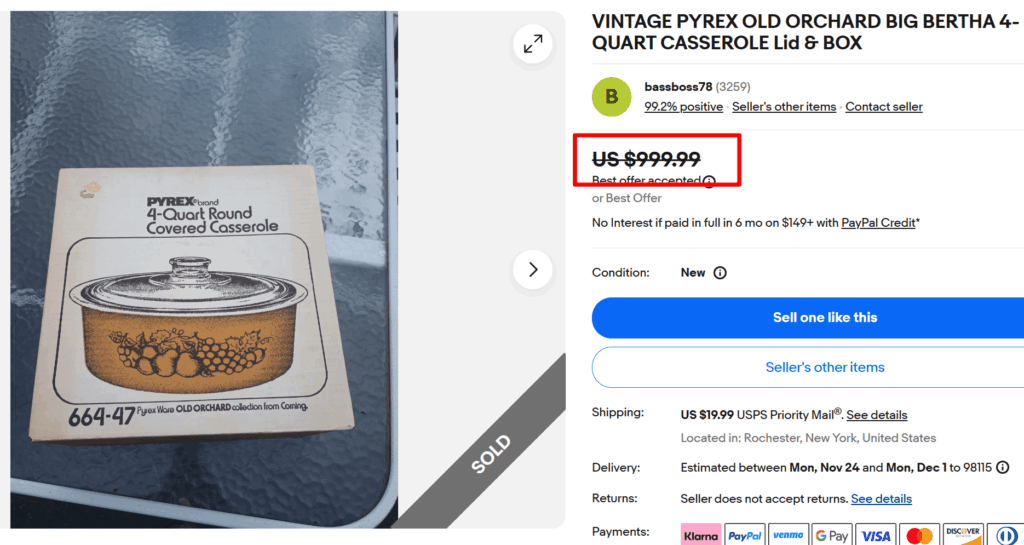
This is an example of the #664-47 Old Orchard casserole. This one is in packed condition, which boosted its value.
10. Dainty Maid Turquoise Diamond (1950s)
Marketed under the promotional pattern ‘Dainty Maids,’ the turquoise diamond pattern is a rare design launched in the late 1950s. It features turquoise diamonds against white milk glass opal. You can find this pattern in mixing bowls and casseroles.
Remember: These pieces were released without any Pyrex backstamp.
- Average Price – $100 to $270 (single pieces); $500 to $850 (complete packs)
- Manufacturing Period – Late 1950s
- Production Status – Discontinued
- Piece Types – #403 Mixing Bowls, Casseroles
- Color – Turquoise on White
- Rarity Level – Rare
- Production Note: Unmarked Promotional Pieces
Valuable Example:
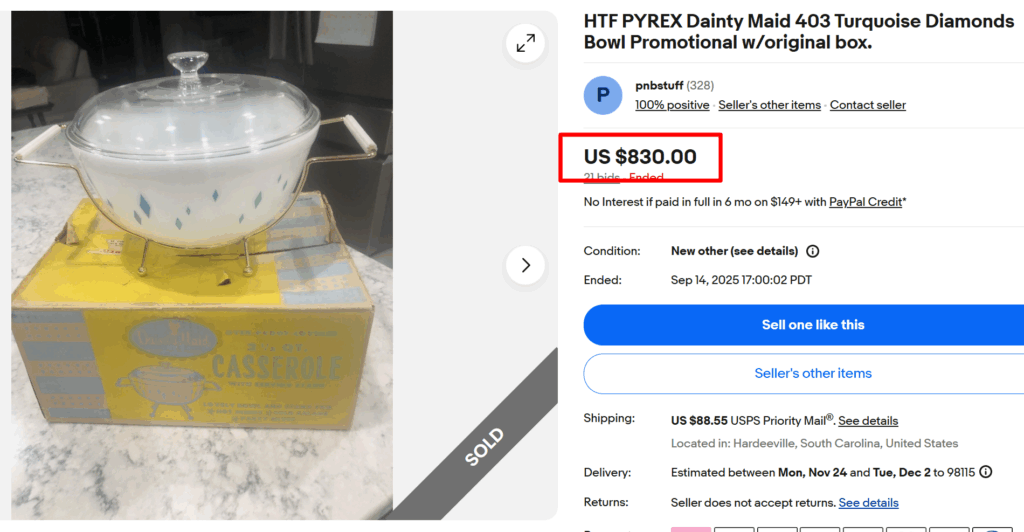
This is #403 Turquoise Diamond mixing bowl, sold for a whopping $830! The high value comes from its completeness, including the original metal cradle, a clear glass lid, and the original box. Since it’s a rare, promotional piece, pieces with original packaging are hard to find.
11. Spirograph (1969 to 1970)
Spirograph pattern is truly unique! While other pattern features are designed on the dish, this one features a geometric design in blue and green tones on the clear glass lid. This promotional design seems inspired by the drawings a popular geometric toy from the 1970s made.
Another interesting fact is that the design is marked on both sides; the blue design is on the lid’s top, and the green design is on the back. But you need to pay attention to spot this difference.
- Average Price – $100 to $350 (for casseroles); $50 to $80 (for lids)
- Manufacturing Period – 1969 to 1970
- Production Status – Discontinued
- Piece Types – Casseroles
- Color – Blue, Green (on the Clear Glass Lid)
- Rarity Level – Very Rare
- Production Notes – Promotional Pieces with Rare Design
Notable Items:
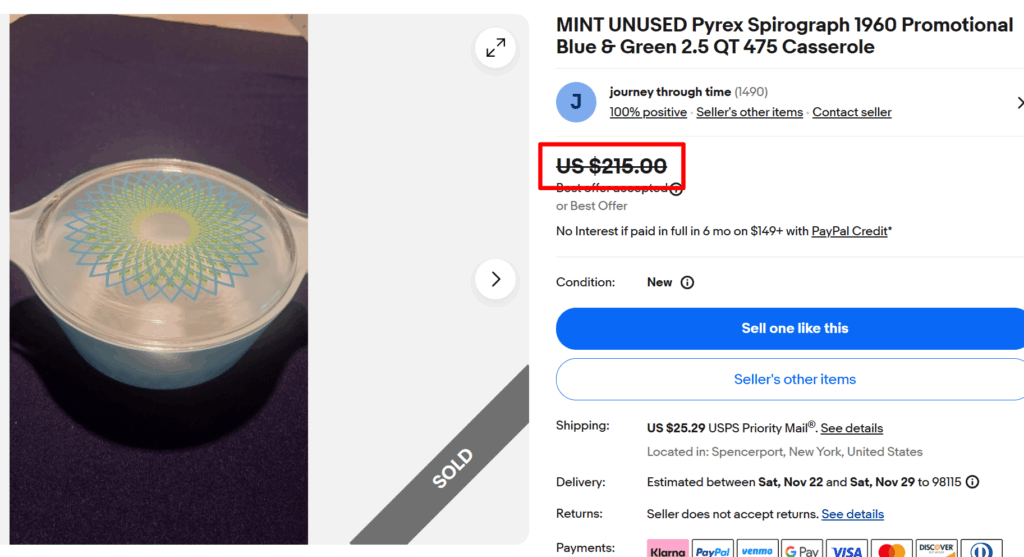
This 2.5 qt #475 Spriograph casserole sold for over $200. Examples with the original box and metal stand can be worth even more. Besides, since this pattern comes on the lid, collectors also love to buy only lids, valued from $50 to $80 in good condition.
12. Dots Pattern (1968 to 1973)
One of the most popular Pyrex patterns, this one shows connected dots of orange, blue, yellow, and green (one color per bowl) in three rows on white opal glass. The size of the dots reduces from top to bottom. The Mid-Century design is also called “Polka Dots” or “New Dots.”
The design was originally released on items #401, #402, and #403, and later on #404, all individually, since it was never made in sets.
- Average Price – $200 to $900
- Manufacturing Period – 1968 -1973
- Production Status – Discontinued
- Piece Types – Single Bowls
- Color – Blue, Green, Yellow, Orange, & Beige Dots on White
- Rarity Level – Common
- Production Note – Not available in sets
Valuable Examples:
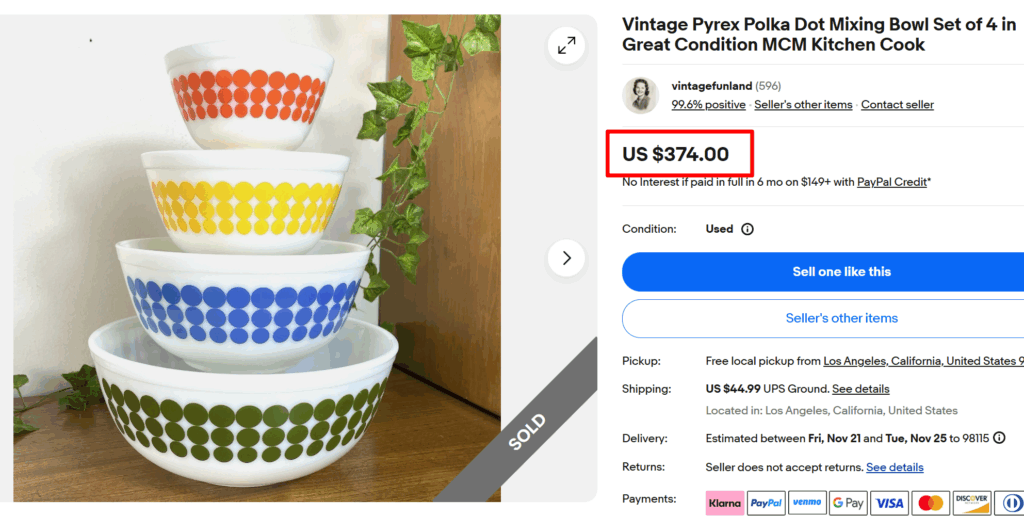
Here is a complete nesting bowl set with the Dots pattern. Since this pattern was not released in sets, finding a full set like this is quite difficult and can cost $300 to $500. Sets with three bowls can sell for $250 to $300, while single bowls are worth around $50 to $250.
13. Snowflake Pattern (1956 to 1963)
Snowflake is one of the first patterns printed in the opal Pyrex line. Advertised as ‘NEW Pyrex Decorator Casseroles’ in the 1950s, this pattern features a white snowflake pattern on a turquoise background.
It’s also available in turquoise on white and white on charcoal shades. Of these, the white-on-turquoise variant had the longest run, making it the most common.
- Average Price – $200 to $850
- Manufacturing Period – 1956 -1963 (White-on-Turquoise variant till 1967)
- Production Status – Discontinued
- Piece Types – Divided casseroles, Oval casseroles, Spacesaver Dishes, Bowls
- Color – White on Turquoise, Turquoise on White, Pink on White, White on Charcoal
- Rarity Level – Common, But the Pink Snowflake is Rare
- Production Note – Limited Production
Notable Examples:
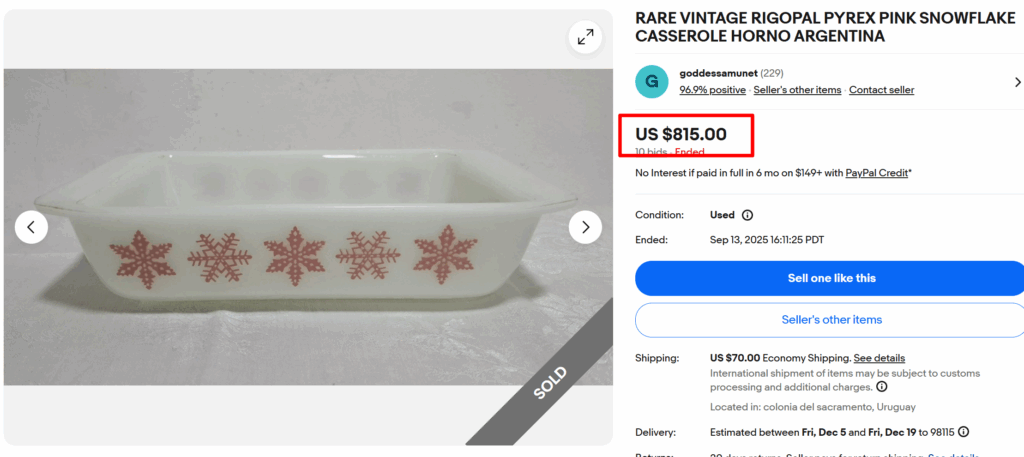
This is an example of the rarest variant of this pattern: Pink Snowflake on White. It’s a rectangular casserole from Argentina’s “Rigopal” brand, which released Pyrex dishes under Corning Glass Works Licence.
14. Blue Stripe/Barcode (1966)
Popularly known as “Barcode” and officially called “Blue Stripes,” this pattern features light blue stripes on a deep blue background resembling a barcode. Since it’s a popular design, it was released in a few other color variants, blue being the most common.
- Average Price – $30-$200 (single or 2-3 pieces); $500-$800 (big sets)
- Manufacturing Period – 1966
- Production Status – Discontinued
- Piece Types – #470-#475, 480 Cinderella Casseroles, Bakeware, Serveware, & Store Sets
- Color – Light Blue Stripes on a Dark Blue, Red/Orange Stripes on White Base
- Rarity Level – Rare
- Production Note – Limited Production
Common Examples:
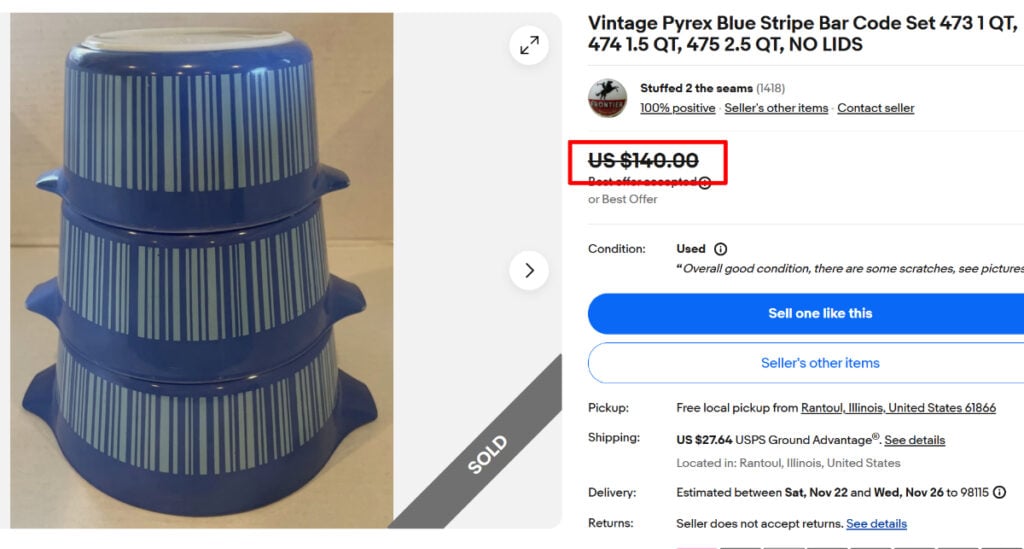
This is a set of three Cinderella-covered casseroles (#473, #474, #475) sold for almost $150. A complete promotional set of five dishes with lids can sell for $500 to $750, with original box and additions.
15. Foulard Pattern (1965)
Foulard Pyrex pattern isn’t much discussed, which makes it collectible in a way. It features 8-pointed and 4-pointed stars arranged alternately on a colored opal glass background.
Pyrex launched this pattern in 1965 and discontinued it the same year. This short run also adds to its scarcity and collectibility. The Foulard pattern was primarily released on beverage sets and later on small cereal bowls.
- Average Price – $20 to $250 (for common pieces); $500+ (brown pieces)
- Manufacturing Period – 1965
- Production Status – Discontinued
- Piece Types – Beverage Sets, Cereal Bowls
- Color – Gold on Navy blue, Brown (Rare)
- Rarity Level – Rare
- Production Note – Short Run of Only One Year
Rare Examples:

This Pyrex Foulard cereal bowl is a very rare combination, with gold or light-brown stars on a deep-brown opal glass. This variant was extremely minimal, with fewer than 10 pieces produced.
Thanks to its rarity, you can expect mint-condition pieces to fetch $500+. The common blue, white, and yellow pieces are worth $20 to $250, depending on whether they’re single pieces or a set.
16. Blue Dianthus (1963 to 1964)
The Blue Dianthus pattern was released in the mid-1960s as a sales test design, with only very few pieces found today. The design features blue dianthus motifs on a milky-white opal or vice versa. But the pattern wasn’t officially named Dianthus; it got its name from the design.
- Average Price – $200-500+ (for single casseroles)
- Manufacturing Period – 1963-1964
- Production Status – Discontinued
- Piece Types – Cinderella Bows, Casserole sets
- Color – Blue on White, White on Blue
- Rarity Level – Rare
- Production Note – Test Item with Limited Pieces
Valuable Examples:
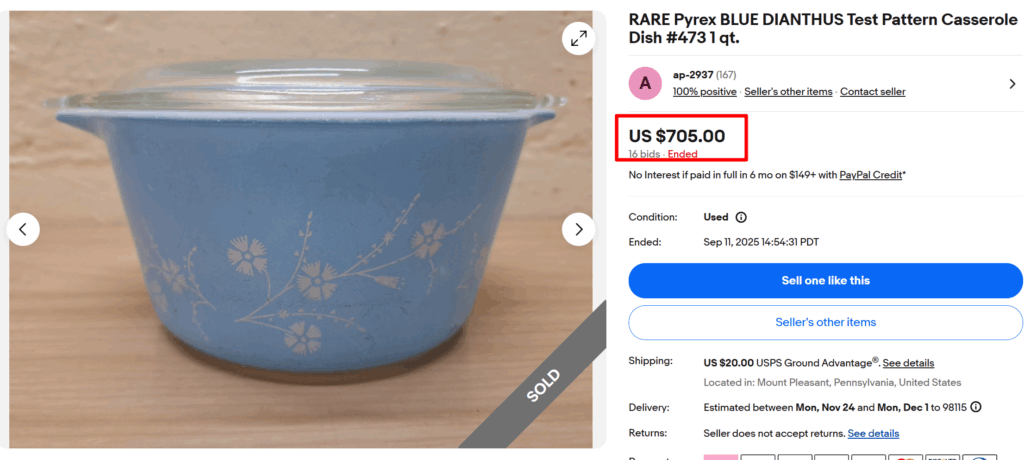
This 473 Blue Dianthus casserole dish, sold for over $700, is one of the very few existing pieces with this pattern. If you can find a complete casserole set with original clear glass lids, it can sell for a higher price.
17. Friendship (1971 to 1974)
To join the country-living interior decor trend in the 70s, Gregory Mirow designed the Friendship pattern in 1971. It shows birds and floral designs in red and orange against white opal glass or vice versa.
Initially, the dishes with this pattern came with clear lids, which were later replaced by opal-white lids with the same design.
There’s also a promotional version of this pattern, called “Penn Dutch,” which depicts a denser floral arrangement in Pennsylvania Dutch style.
- Average Price – $50 to $350
- Manufacturing Period – 1971-1974
- Production Status – Discontinued
- Piece Types – Mixing Bowl Sets (400 &300), Cinderella Bowl Set (441-44), Refrigerator Set (501-03), Round Casserole set (471-475)
- Color – Red and Orange on White Base/ White on Red-Orange Base
- Rarity Level – Common
Sold Examples:
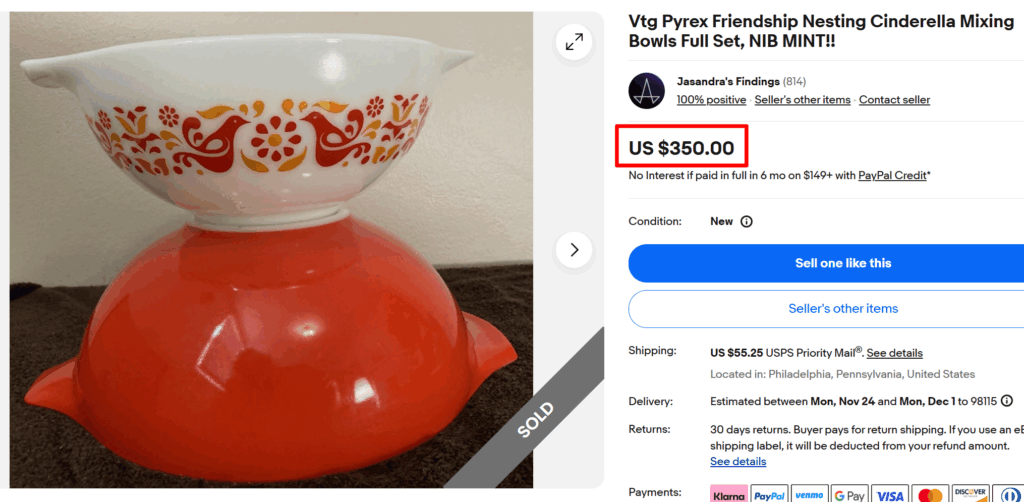
Here is a set of #441-444 nesting Friendship Cinderella bowls. The set has two bowls with red-orange designs on white bases, an orange bowl with white motifs, and a red bowl with white designs. The country vibes of these pieces have a big fan base!
18. Forest Fancies (1981 to 1986)
Designed by Marc G. Rubin, this retro pattern shows a whimsical pencil-drawn field of mushrooms on a speckled cream or beige background. This pattern is one of the last four in the Pyrex opal series, making it rare.
- Average Price – $40 to $400
- Manufacturing Period – 1981-1986
- Production Status – Discontinued
- Piece Types – Mixing Bowls, Cinderella Bowls, Bakeware & Serving Pieces.
- Color – Brown on a Beige/Cream Background
- Rarity Level – Common
Notable Examples to Check:
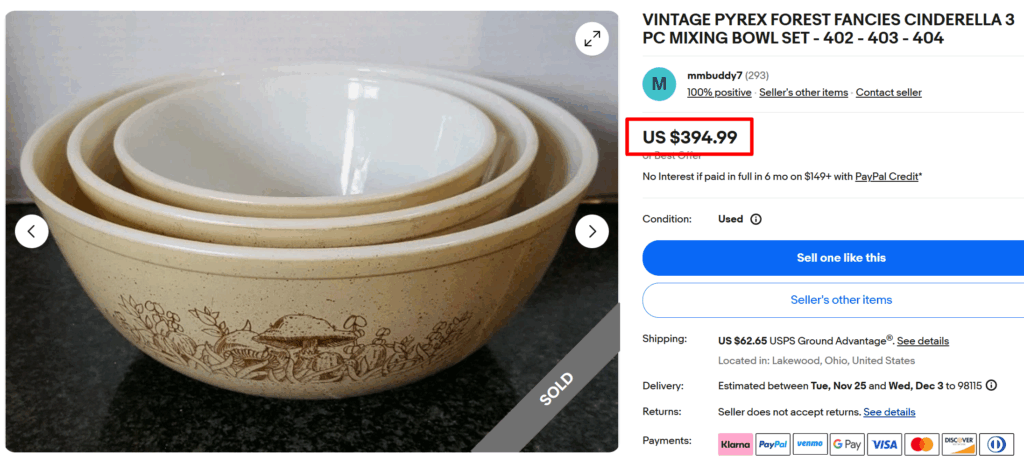
This is a Forest Fancies mixing bowl set of three. Finding sets like this can be difficult today, making them worth a few hundred dollars. Casserole sets are common and hence worth $150 to $200+, depending on packaging and condition.
19. Pink Stripe (1965 to 1967)
This minimal pattern is part of the “Rainbow Stripes” pattern line and features horizontal pink stripes on a white background. Along with pink, you can find this design in blue, sandalwood, and yellow strips. But the popularity of the pink-hued Pyrex makes this a highly sought-after pattern.
- Average Price – $50 to $350
- Manufacturing Period – 1965 to 1967
- Production Status – Discontinued
- Piece Types – Mixing Bowl Set
- Color – Pink Stripes on a White Base
- Rarity Level – Rare
- Production Notes – A Short 2-year Run with Limited Pieces
Collectible Pieces to Check:
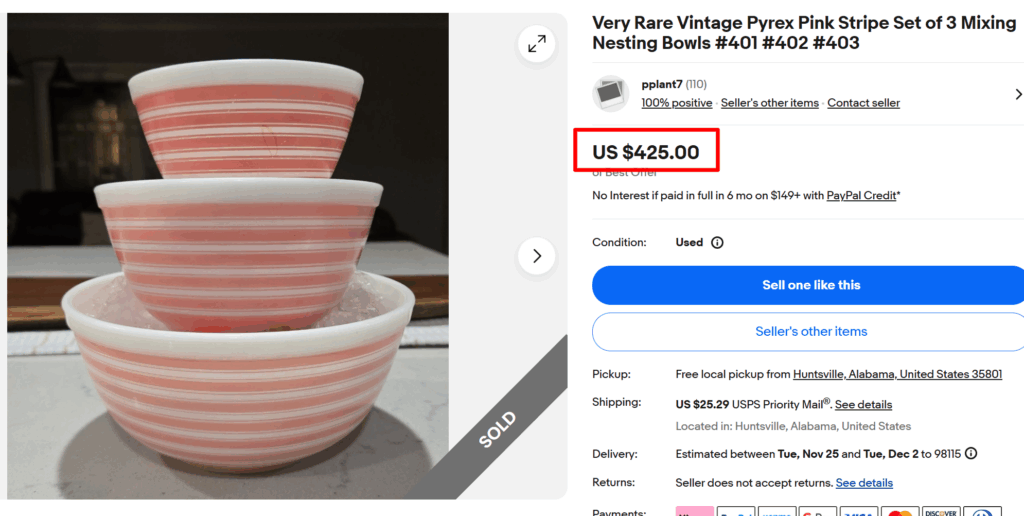
This 3-set mixing bowl with a pink stripe pattern is rare due to the limited number produced. These bowls are available as a complete set or as individual pieces. The value can range from $50 to $250+ for single pieces, depending on size and condition.
20. Christmas Winter Festival
This Christmas-themed Pyrex pattern is super rare, as it was launched as a seasonal promotion item. The pattern shows a white reindeer, snowmen, Christmas trees, and dots on a bottle-green background. Another variant shows white motifs on a red base, which is quite common!
- Average Price – $200 to $900
- Manufacturing Period – 1990s
- Production Status – Discontinued
- Piece Types – Mixing Bowls
- Color – White on Green (Rare), White on Red
- Rarity Level – Rare
- Production Notes – Seasonal Run with Limited Pieces
Rare Pieces to Look:

This single winter/holiday-theme Pyrex bowl #323 is a perfect example of the rare green variant; no wonder it sold for such a steep price. The more common version with a red base generally goes for $50 to $250+!
Wrapping Up
Vintage Pyrex might look ordinary. But some patterns are way more valuable than expected due to their cultural significance, details, and uniqueness. Now that you know which vintage Pyrex patterns and dishes are worth more, you’ll surely spot a treasure next time you see one!
Note: This article is intended for informational, educational, and entertainment purposes only. Some images are illustrative and may not represent actual brands, products, or related entities. All trademarks, product names, brand logos, packaging, and other intellectual property referenced remain the exclusive property of their respective owners. Any brand mentions or references are provided solely for descriptive and educational context and do not imply any formal or commercial association.

